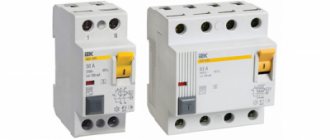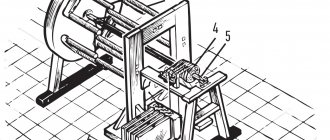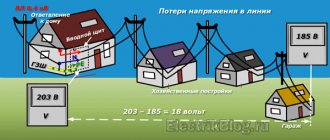Great Electrician Encyclopedia (2016)
Author : Yu.M. Chernichkin
The book will be useful to those involved in home electrical work. The material is given from basics to professional level. Simple explanation of complex processes. The book is supplied with illustrations. It reveals the problems that an electrician faces when working with electricity and electrical equipment. Types of cables, cords and wires, installation and repair of wiring - you will find all this in the encyclopedia. The book is intended for both professionals and self-taught craftsmen.
What is electricity
Electric current is the movement of charged particles (electrons), which, like any movement, can be directed to perform useful work. 2 basic units of electricity:
- this is the voltage (measured in volts and denoted by the letter B or Latin V);
- current strength (measured in amperes and denoted by the letter A).
For simplicity, let's compare electricity to water flowing through pipes. Using the example of water, voltage can be understood as the force with which water is pushed out of a source (pump), and current strength can mean the amount of water passing per unit time through a section of a pipe of a certain diameter (wire cross-section). As in the case of water in electrical engineering, the cross-section of the wire is selected depending on the strength of the current - an incorrectly selected wire will simply burn out when a current of greater strength passes through it than it was designed for. It should also be noted that electric current can only flow in a closed circuit and can be constant or variable. Let's look at this point in more detail.
Electric current is the movement of charged particles
Direct current flows in one direction from the positive pole of the source (+) to the negative (-), while alternating current changes the direction of movement at a given frequency. Frequency is another unit of measurement that only applies to alternating current. Essentially this is the number of changes in the direction of current movement per second. Frequency is measured in Hertz and is denoted by the letters Hz, or the Latin Hz. So in a household electrical network, the current frequency is 50 hertz, that is, the current changes its direction 50 times per second. It’s worth telling a little more about alternating current. So in a household single-phase electrical network there are 2 wires - one of them is a phase (it is the current that is supplied to it from the power plant), the second wire is a neutral wire. Essentially, 0 is an empty wire through which the current returns back to the power source (as we remember, electricity can only flow in a closed circuit), but from a safety point of view. You shouldn't rely on this. For example, in a closed circuit, dangerous voltage is present on both wires. In general, caution is the main rule when working even with seemingly low and safe voltage. Having dealt a little with the theory (which we will return to later), let’s move on to more practical things that will be useful in further work with electricity.
Video - What is electricity
Electrician's General Book. The Ultimate Guide (2014)
Author : V.M. Zhabtsev
This publication will help those who decide to independently repair electrical wiring at home, without the help of a professional electrician. Here you will find all the necessary information about the tools needed for repairs or other work; about wires and how to choose them correctly; about how to calculate your home network; about personal safety when working with electricity and other processes related to electricity. An informative publication with illustrations.
Concepts and properties of electric current
Electrical laws and formulas are required not only for carrying out any calculations. They are also needed by those who practically perform operations related to electricity. Knowing the basics of electrical engineering, you can logically determine the cause of the malfunction and eliminate it very quickly.
The essence of electric current is the movement of charged particles that transfer electric charge from one point to another. However, with the random thermal movement of charged particles, following the example of free electrons in metals, charge transfer does not occur. The movement of electric charge through the cross section of a conductor occurs only if ions or electrons participate in ordered movement.
Electric current always flows in a certain direction. Its presence is indicated by specific signs:
- Heating a conductor through which current flows.
- Change in the chemical composition of a conductor under the influence of current.
- Exerting force on neighboring currents, magnetized bodies and neighboring currents.
Electric current can be direct or alternating. In the first case, all its parameters remain unchanged, and in the second, the polarity periodically changes from positive to negative. In each half-cycle, the direction of the electron flow changes. The rate of such periodic changes is frequency, measured in hertz
Installation and operation of electrical wiring (2011)
Author : V.I. Nazarova
The book is needed by those who will be faced with electrical installation work during the construction or redevelopment of a cottage, residential building or summer house. Everything about how to properly install electrical wiring, sockets, switches, panels and lamps. An indispensable book in the work of a professional electrician and home craftsman.
Modern Electrician's Handbook (2016)
Author : A.V. Suvorin
The book is intended for engineers and technicians specializing in electrical supply (by industry), for electricians and electricians. The reference book presents a huge theoretical base on the general technical provisions necessary for an electrician. The book contains information on electrical engineering and materials necessary for work, a brief description of lighting equipment, transformers, and DC machines. It also provides information on working with electronic devices and their use. The information in the directory is presented in accessible language.
Safety and Practice
Basic electrical engineering for beginners places special emphasis on safety rules. Failure to comply with them in practice can sometimes result in electrical injuries and property damage. For beginners in electrical engineering, you need to follow four basic safety requirements.
Four safety rules for beginners:
- Before operating any device or equipment, you should read its documentation. All instruction manuals have a safety section. It describes hazardous practices that may cause a short circuit or electric shock.
- Before you begin working on electrical devices or wiring, turn off the power. Then inspect the condition of the conductor insulation. If a violation of the insulating coating is detected, then the exposed part of the conductors must be covered with a piece of insulating tape.
- When working with live wiring and equipment, you should use dielectric gloves, safety glasses and shoes with thick rubber soles. There is absolutely nothing for beginners to do in electrical distribution cabinets, switchboards and electrical installations. They are carried out by qualified electricians who are certified to work under voltage.
- Under no circumstances should you touch exposed conductors with your hands. For this, there are test screwdrivers, multimeters and other electrical measuring instruments. Only after making sure that there is no voltage can you touch the wires.
Electrician's Handbook for Pros and more... Modern technologies of the 21st century (2013)
Authors : S.L. Koryakin-Chernyak, M.A. Shustov, O.N. Partala, A.V. Povny, S.B. Shmakov, V.Ya. Volodin, E.A. flour mill
The electrician's directory is needed by those who are looking for all the necessary information in one place. Physical and technical characteristics, conceptual apparatus, names of devices and materials, markings, designations - you will find all this here. The book contains a large amount of electrical information, which is organized into sections and areas of activity of a professional electrician. The reference book is necessary for both a professional and someone who is just learning.
Home Electrician and More (2003)
Author : V.M. Pestrikov
Popular two-volume book. The first book covers issues related to working on electricity in the city, and the second - at the dacha, garden plot and simply at leisure. In an entertaining and simple form, the main issues in the field of electricity, as well as in related areas: radio electronics, television and cellular communications, and security systems are discussed. The purpose of the book is to help anyone who wants to learn how to repair electrical networks and electrical equipment, as well as create simple electrical appliances.
Master Electrician's Handbook. Wiring, sockets, safety precautions, tools
Modern civilization is impossible without electricity. A variety of instruments and devices surround us on all sides. They are pushing cars with internal combustion engines off the roads! Often people don’t even notice the ubiquitous “volt-ampere workers” - until an emergency situation arises: lighting disappears, water does not flow, there is no connection, including cellular, no Internet. And then there is a “catastrophe”. Until the 80s of the last century, the list of electrical household appliances was nowhere shorter - a TV, a vacuum cleaner, an iron, a radio (music center), a refrigerator, a washing machine (not for everyone), light bulbs and, for some, some kitchen appliances. Consequently, the power consumption was quite modest; one or two sockets and one lighting point were enough for one room. In just thirty years, the tandem of engineering and commerce, the engines of scientific and technological progress, has expanded the above modest list almost to infinity. Miniaturization, digital and energy-saving technologies have made it possible to significantly reduce the corresponding avalanche-like growth in energy consumption, however, the requirements for household (apartment and intra-house) electrical networks have increased significantly. The total power, the total number and dispersed location of electricity consumption points require careful and accurate calculation of power supply schemes, as well as the quality of the corresponding communication devices (sockets, switches), protection (safety) and other consumables. The main goal of this book is to help the reader navigate the modern variety of devices, instruments, conductors and circuits. A brief theoretical overview of the basics of electrical engineering will help even a non-professional to correctly calculate the required maximum power for the correct selection of conductors and safety and protection devices. The most common standard electrical connection diagrams will help in drawing up and improving the general electrical diagram of an apartment or private household. An overview of cable and wire products, some new installation products and light bulbs, as well as comparative tables given in the book, will be useful to amateurs and professionals. Practical advice will help you overcome most of the problems that arise during the installation and installation of electrical elements in your home at minimal cost.
All about electrics (2016)
Authors : M. Chernichkin, S. Stepanov, I. Ekimov
The book is intended for those who are faced with repairing electrical wiring in an apartment. Step-by-step explanation for solving electrical problems. The material is supplied with a large number of illustrations. From it you will learn about the materials and tools needed in the work of a master, about the features of electrical equipment in an apartment and street. Information is also provided on the electrification of the bathroom and kitchen. The book will be useful not only for beginners, but also for professionals.










